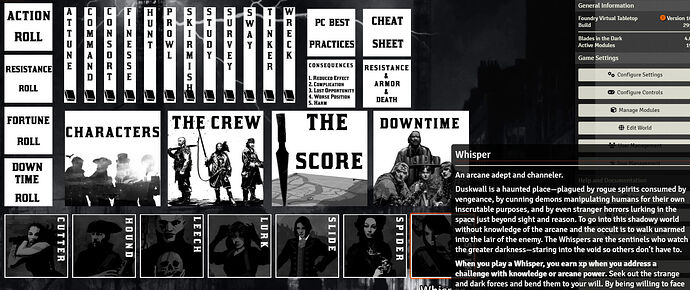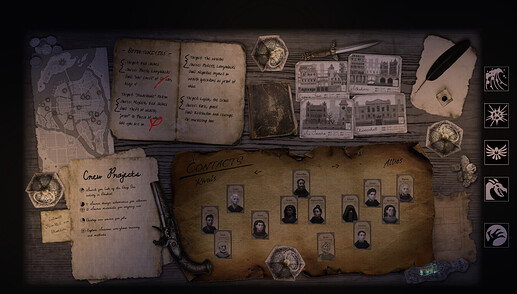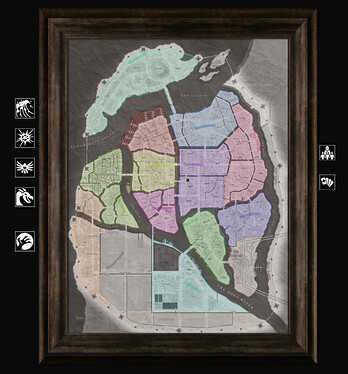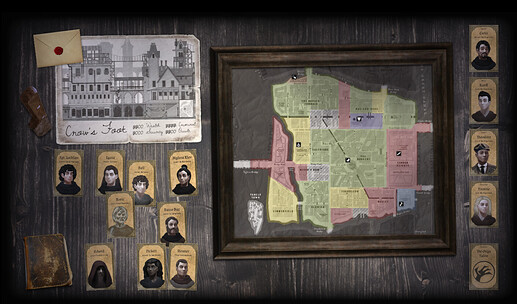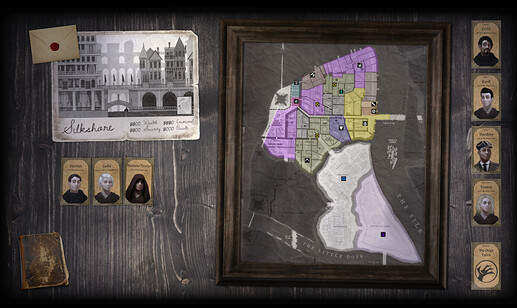Hi, first time BitD GM prepping. It’s mostly creating some nice macros to roll names, locations etc and switch scenes with zoom in to locations. Much lighter prep than other RPGs. HOWEVER…
The rules are the item most in need of an approach so I’ve created a scene with tiles, journal links, and app called Pin Cushion with hover over. It may be first-time nervous over prep, or perhaps it will be a super-useful in-game rule lookup without having to search journals. I think it may be good since we won’t be doing lots of maps and other visuals necessitated by round-by-round combat, so we are likely to sit on the rule scene except for flavor scenes now and then.
But, since I have not run it yet, it’s all in my head. Any BitD GM/player experiences that are Foundry-specific I should think about, be aware of? Thanks much!
1 Like
Personally, I have gone the route of creating thematic, interactive areas for the players to utilized during play.
Here are a few of the pages/set up areas I have made in my foundry for my BitD game:
Main Landing: “Planning Table”
This is the main landing page, were we spend the majority of our play time.
- The book open book has simple text about score leads.
- There is a LTP area with the clocks and a text description
- The city map (upper left corner) has rough location markers for friends, rivals, vice purveyors and such.
- The large “contacts” area has movable token “cards” for the NPCs that maps relationship shifts with key NPCs over time.
- The small closed journal (center) and the ink/quill/paper are tokens to open the faction relationship tracker sheet for factions (journal) and citizenry (ink/quill).
- Player chosen character icons are tokens to open character sheets.
- Adding and removing small elements as they relate to the fiction (e.g. the spirit bottle containing Roric’s ghost who recently surprised them)
City Map with Colored Districts
I used the high detail city map by Old Dog Games (link) to let players explore the whole city as we make the fiction together.
I did add colored drawing layers over for easier district identification. Also, the player character icons for quick sheet access, as well as faction and citizenry tracker sheet icons.
District “Scenes”
This is my most recent addition, where I have a scene for each of the districts with a detailed map from the previous mentioned pack, covered with drawing layers to show claimed turf of all the factions. Really tried to dig into the “every square foot is claimed by someone” but made them as layers so that they can ebb and flow as the game progresses.
- I mainly use these scenes when we are “actively present” in a district, i.e. a score or free play.
- Journal token for faction relationships and sealed letter for citizenry relationships.
- Once again, NPC token “cards” for important NPCs located in the district.
- These pages, I added the PC “cards” for tokens rather than just the icons. I like that this gives a little more of a “character scene” and will even sometimes move the NPC/PC tokens together on the scene during an interaction.
(I realized after I typed this up that I am not sure it addresses your question/post directly, but wanted to share as I did type it up…sorry!)
2 Likes
Heck yeah, very inspirational . . . I like this idea of each district scene being a bit more interactive . … hmm . . .I’ll have to think about this. I really like the cards instead of token . . . yeah, I think my RULES scene is one thing but I may spruce up the district scenes.
I’ll check out the resource link for sure. Just beautiful scenes though.
is the crew projects in the main plainning scene baked into the background graphic or somehow interactive tile or layer above that cool backgtround?
Everything is a tile, token, text/drawing, or journal tag.
The crew projects is just text from the foundry drawing tools over top of a cool paper png tile with the built in clock (tile shrunk down to match the style).
I like your rules page, that is something I haven’t really incorporated well and really struggled to include in any way. I have the advantage that my current campaign is made up of 4 players pretty familiar with the rules and several have or are currently GMing for other groups or one shots.
1 Like
awesome, well i’m inspired so that’s great. my group is ex-DnD and now involved in my Mutant Year Zero and Mork Borg campaigns . . . but Blades is such a different beast . . . not having “rounds” for combat etc.
so excited to dive in thanks for all the tips and talk 
1 Like
